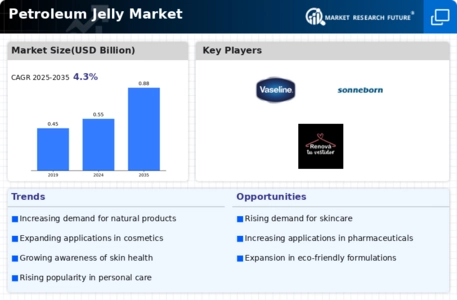Market Analysis
In-depth Analysis of Petroleum Jelly Market Industry Landscape
The petroleum jelly market dynamics are influenced by various factors that impact its demand, supply, and overall growth trajectory. Petroleum jelly, also known as petrolatum, is a versatile and widely used product with applications in skincare, pharmaceuticals, cosmetics, and industrial sectors. Market dynamics in this industry are driven by changes in consumer preferences, regulatory policies, technological advancements, and competitive pressures.
One of the primary drivers of market dynamics in the petroleum jelly industry is shifting consumer preferences and lifestyle trends. As consumers become more health-conscious and seek natural and organic alternatives in skincare products, the demand for petroleum jelly faces some challenges. However, petroleum jelly remains popular due to its effectiveness as a moisturizer, protectant, and barrier agent, particularly in harsh weather conditions or for treating dry skin and minor cuts or burns. Moreover, its affordability and long shelf life continue to attract consumers, especially in developing regions where access to alternative products may be limited.
Technological advancements play a significant role in shaping the dynamics of the petroleum jelly market. Innovations in refining processes, formulation techniques, and packaging technologies have led to improvements in product quality, purity, and usability. Manufacturers are investing in research and development to enhance the texture, consistency, and performance of petroleum jelly while minimizing impurities and odors. Additionally, advancements in packaging, such as convenient squeeze tubes and portable containers, contribute to the convenience and accessibility of petroleum jelly products for consumers.
Furthermore, regulatory factors influence the dynamics of the petroleum jelly market, particularly in terms of quality standards, labeling requirements, and safety regulations. Regulatory agencies impose stringent guidelines to ensure the purity, safety, and efficacy of petroleum jelly products, thereby enhancing consumer confidence and market credibility. Compliance with these regulations is essential for manufacturers to maintain market access, avoid product recalls or legal liabilities, and uphold brand reputation. Moreover, growing awareness of environmental issues and sustainability concerns may lead to increased scrutiny of petroleum jelly production processes and raw material sourcing practices, prompting companies to adopt eco-friendly and ethical manufacturing practices to mitigate environmental impacts.
Competitive pressures also shape the dynamics of the petroleum jelly market, with numerous players vying for market share through product differentiation, pricing strategies, and marketing initiatives. The market is characterized by the presence of both established multinational corporations and smaller regional players offering a wide range of petroleum jelly products targeted at different consumer segments. Intense competition drives innovation and drives companies to develop value-added products, such as scented or flavored variants, specialized formulations for specific skincare needs, or packaging innovations that enhance convenience and portability. Additionally, strategic partnerships, collaborations, and acquisitions enable companies to expand their product portfolios, access new markets, and leverage synergies to gain a competitive edge in the marketplace.
Economic factors also influence the dynamics of the petroleum jelly market, including disposable income levels, population growth, and economic development. As disposable incomes rise and living standards improve, consumers are more likely to spend on personal care and grooming products, including petroleum jelly. Moreover, population growth, urbanization, and changing lifestyles contribute to increased demand for skincare products, driving market growth in both developed and emerging markets. However, economic downturns or fluctuations may impact consumer spending habits and purchasing power, leading to shifts in market demand and sales performance.

















Leave a Comment